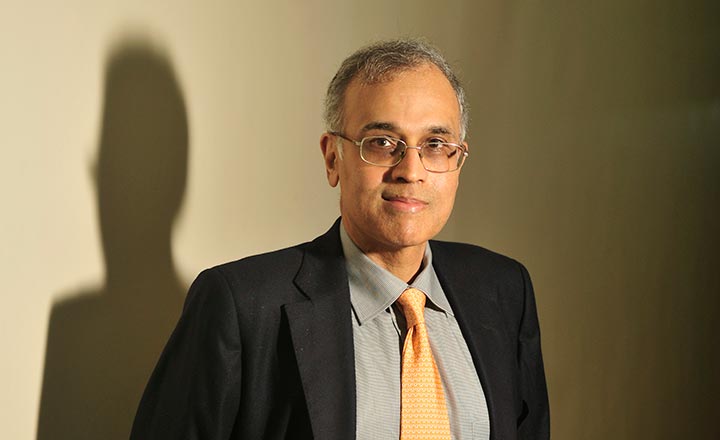Augustine of Hippo, whose writings influenced the development of Christianity and Western philosophy, wrote in his book, Confessions, about his struggle with doubts and temptations on his conversion to Christianity. He called this the ‘agony of hesitation’.
Investors may well have experienced a different form of the ‘agony of hesitation’ because doubt is a soulmate in a world of chance. Here are a couple of current personal examples.
Moats can never be clearly visible through the smog of capital misallocation. Peer through the haze and one thing is clear — a company such as General Electric (GE) could not have had a distinguished 100-year existence without a significant moat. That heritage includes a formidable foundation of installed industrial equipment spanning areas as diverse as aerospace, power and healthcare, cocooned in a digital ecosystem. The growing service revenue stemming from maintenance, repairs and upgrades led to deep customer relationships, customer captivity and switching costs. The very scale at which GE operates leads to economies of scale and its recent stated commitment to cost control and proposed shedding of assets of $20 billion should, hopefully, translate into a more focused and leaner organisation.
GE has pioneered many technologies in the past. Competitors may have better operating margins on comparable R&D percentage spends, but GE benefits from its ability to use products from new technologies, such as additives, across its business units, giving them a significant competitive edge.
These moats are being tested in GE’s power business, which accounts for a third of its industrial revenue. Blame the renewable energy revolution for that, because sales of large gas turbines have plummeted globally. A shrunken pie has led to intense competition for new orders and also for the more-profitable service business. The fall in sales may not be cyclical but structural, owing to falling costs of solar and wind power. While GE is a major player in the highly-competitive wind turbine business, the lead in solar is mainly with Chinese companies.
Capital was misallocated as GE increasingly bet on fossil fuels with the acquisition of the power business of Alstom in 2015. There were other capital allocation decisions such as the acquisition of oil and gas assets which were probably not wise, as was the underfunding of pension.
Will capital be more prudently managed in the future? There seem to be some reasons to believe so, a) The recent dividend cut of 50% to align payouts to cash flow generation b) Simplification of businesses retained c) Managerial incentives to focus more on return at all levels of capital allocation and d) The presence of an activist investor (Trian Partners) on a shrunken board of directors.
An asset-value approach for a conglomerate as complex as GE indicates a range which varies from numbers slightly higher than the current enterprise value to more optimistic numbers. A complete break-up of GE is unlikely. Based on historical valuation metrics such as median dividend yield and price earnings ratios, there could be some more downside to GE from the current level of $18.
Except with the benefit of hindsight, it would be hard to call the point of maximum pessimism or total capitulation, with 40% of GE’s market capitalisation having already eroded year to date. But insider buying has started at current levels.
After a small initial commitment to GE shares, I am currently undergoing the agony of hesitation.
Another iconic company, Walt Disney, has had to pull up the drawbridge as its media magical kingdom has come under attack. It is Disney’s media division, which owns cable networks such as ESPN and Disney Channel and broadcasting network ABC, which is fighting its own version of Star Wars with streaming OTT platforms such as Netflix.
Disney has an enviable brand. It has created and owns legendary characters and franchises and has been able to seamlessly monetise them across multiple platforms — movies, merchandising and theme parks, among others. The intellectual property that Disney owns and its demonstrated ability to create new franchises and monetise them in myriad ways is its strongest moat.
However, selling subscription-based digital services (such as the to-be-introduced sports-themed ESPN streaming service) directly to customers in a marketplace in which it does not have the first-mover advantage will need new capabilities, even for a media monarch such as Disney. Disney’s acquisition of a controlling stake in BAMTech will bring in technological capabilities for providing new streaming services and enable it to learn more about the behaviour of its viewers to customise offerings. Any acquisition of some of 21st Century Fox’s assets, such as Hulu, would accelerate Disney’s ability to gain scale in streaming services.
Disney’s competitive edge for new services would be the exclusive content based on the intellectual property it already owns and its creative teams. It would spend substantially less than Netflix on content creation and be focused on profitability rather than market share in the direct-to-consumer space. Following a niche strategy makes sense when the trend towards multiple streaming services by households is growing. A value proposition by Disney could coexist with Netflix. It could possibly replace lost cable network revenues with higher-margin streaming services revenues and change the declining profitability trend in the media networks business.
Any DCF-based valuation approach based on some degree of uncertainty on growth could throw up a wide range of values. The current price of Disney (around $103) is at a 25% premium to many bear case estimates. A sum-of-the-part valuation indicates materially higher asset values although there is little chance of any of these assets being spun off. I am still waiting to increase the small initial commitment to Disney shares I made recently at lower levels.
Returning to St. Augustine, in Confessions, he stated that he was influenced by the writings of Cicero. He quoted: ‘It is not the discovery but the mere search for wisdom which should be preferred even to the discovery of treasures.’ This search for wisdom goes some way in lessening the ‘agony of hesitation’.












